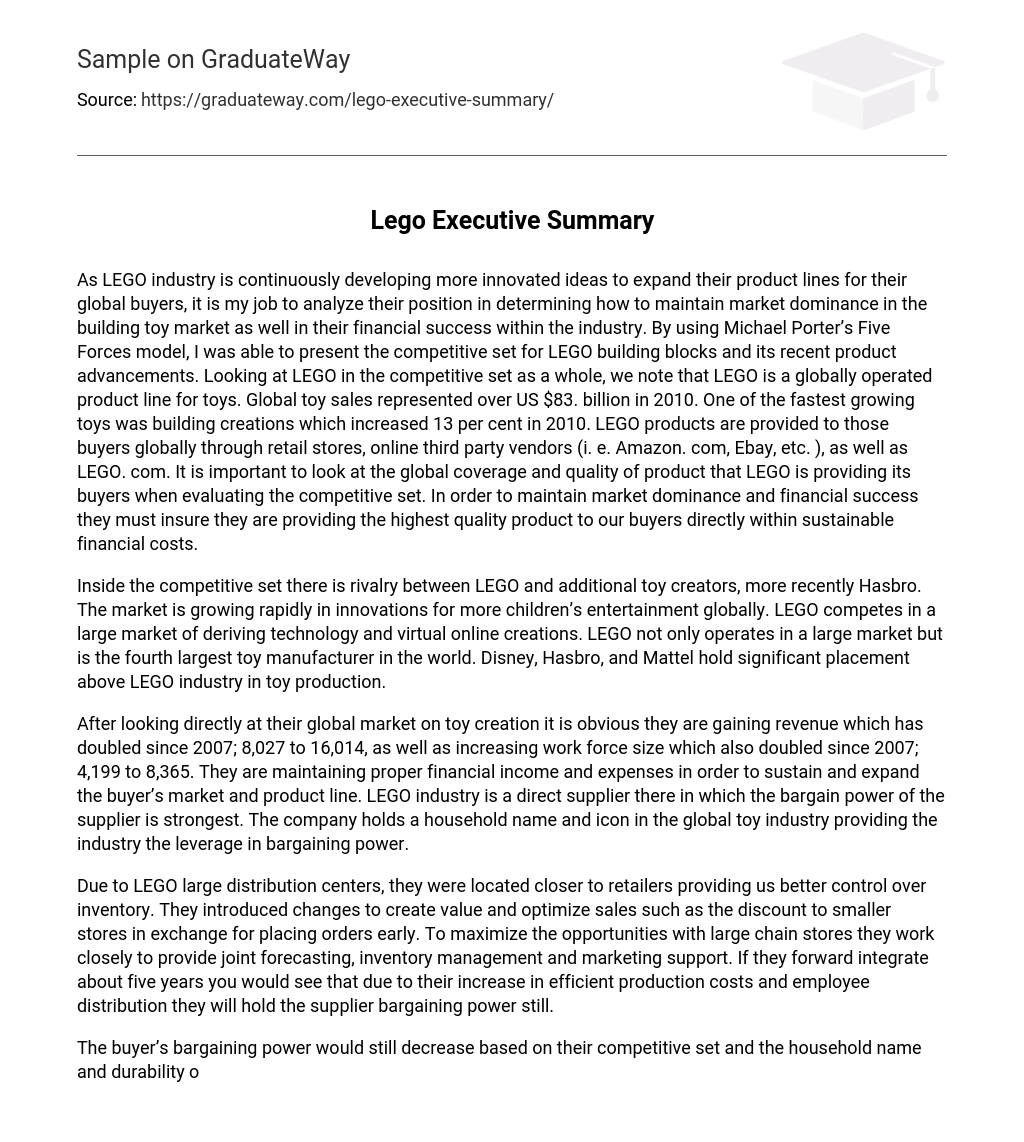As LEGO industry is continuously developing more innovated ideas to expand their product lines for their global buyers, it is my job to analyze their position in determining how to maintain market dominance in the building toy market as well in their financial success within the industry. By using Michael Porter’s Five Forces model, I was able to present the competitive set for LEGO building blocks and its recent product advancements. Looking at LEGO in the competitive set as a whole, we note that LEGO is a globally operated product line for toys. Global toy sales represented over US $83. billion in 2010. One of the fastest growing toys was building creations which increased 13 per cent in 2010. LEGO products are provided to those buyers globally through retail stores, online third party vendors (i. e. Amazon. com, Ebay, etc. ), as well as LEGO. com. It is important to look at the global coverage and quality of product that LEGO is providing its buyers when evaluating the competitive set. In order to maintain market dominance and financial success they must insure they are providing the highest quality product to our buyers directly within sustainable financial costs.
Inside the competitive set there is rivalry between LEGO and additional toy creators, more recently Hasbro. The market is growing rapidly in innovations for more children’s entertainment globally. LEGO competes in a large market of deriving technology and virtual online creations. LEGO not only operates in a large market but is the fourth largest toy manufacturer in the world. Disney, Hasbro, and Mattel hold significant placement above LEGO industry in toy production.
After looking directly at their global market on toy creation it is obvious they are gaining revenue which has doubled since 2007; 8,027 to 16,014, as well as increasing work force size which also doubled since 2007; 4,199 to 8,365. They are maintaining proper financial income and expenses in order to sustain and expand the buyer’s market and product line. LEGO industry is a direct supplier there in which the bargain power of the supplier is strongest. The company holds a household name and icon in the global toy industry providing the industry the leverage in bargaining power.
Due to LEGO large distribution centers, they were located closer to retailers providing us better control over inventory. They introduced changes to create value and optimize sales such as the discount to smaller stores in exchange for placing orders early. To maximize the opportunities with large chain stores they work closely to provide joint forecasting, inventory management and marketing support. If they forward integrate about five years you would see that due to their increase in efficient production costs and employee distribution they will hold the supplier bargaining power still.
The buyer’s bargaining power would still decrease based on their competitive set and the household name and durability of their products. Buyers will continue to pay what is posted for products as long as they withstand their buyer-supplier trust. In their competitive set we find that they have had several competitors with close substitutes for their product. MEGA Bloks held license agreements with popular items such as HALO video games, Marvel Comics, Disney, Thomas the Train, Hello Kitty, Nickelodeon, and Caterpillar Construction Equipment.
Their sales revenue was significantly smaller than LEGO, but still had posed a threat of paying less for a similar product. The new line of building blocks launched by Hasbro called Kre-O has presented itself strongly to the buyer’s due to Hasbro’s strong brand power and product line. Kre-O has launched a new era for building blocks that has not been innovated before until now. Disney holds a favorable relationship with Hasbro and Mattel which pose a greater threat to them at least until the year 2017 for their overall product line of building blocks.
In an overall market LEGO holds threats from all toy production industries while they are fighting for the same buyer’s market. However, with these close substitutes LEGO has upheld its household name and have acquired brand loyalty from their buyer’s providing them with a smaller threat of abandonment to other substitutes. I do not see a high risk of potential entrants facing LEGO industry. LEGO holds a strong brand preference and high degree of customer loyalty since the late 1930’s. They have buyers who have followed their products since they were children.
This in turns creates a larger pool of their buyer loyalty. Their product has been offered over 50 years and held strong with mottos that inspire our children and families to experience “endless human possibility. ” With the strong attachment of buyers to the brand, it presents a harder task for a newcomer to break into the market. With the large amount of production changes over time they have presented a large struggle for potential entrants with higher capital requirements to even begin to start their productions.
LEGO holds a strong network of distributors-retailers which allows them the space provided for their products. A potential entrant would face distribution challenges especially with large sellers such as Wal-Mart whom carry their supply. Reviewing the past five years from 2006 to 2011, LEGO has seemed to continue to expand production from hands on building toys to the virtual online LEGO Universe. The innovative online virtual universe allows many consumers to design and personalize their own figures and worlds in the comfort of their own surroundings.
They have created the option of individuals creating their own product and purchasing it for themselves or others. Fast forwarding five years from now to 2016, LEGO will continue to be a dominating producer for children’s learning and imagination. LEGO will continue to face competition with Hasbro and Mattel through toy production; however LEGO continues to offer brand loyalty and continuous growth in technological changes and enhancements to children’s entertainment.





